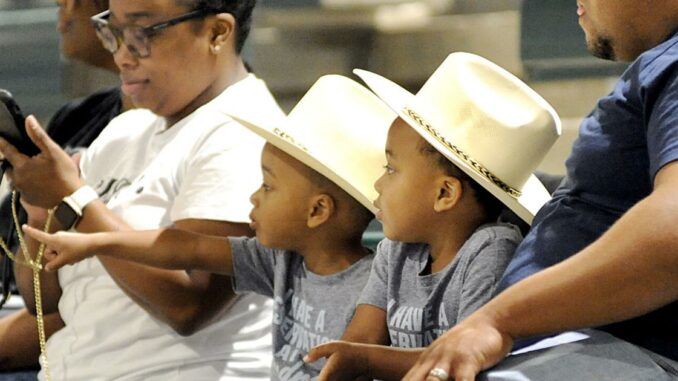
Kansas is getting older, too. The median age in roughly half of the counties in western Kansas is now higher than the national average. The U.S. Census Bureau predicts that nearly a quarter of Kansans will be over the age of 60 by 2030 — an increase of 32% since 2012.
Ginther, who grew up on a farm in Wisconsin, said it’s understandable that some young people may want to leave agriculture. It remains a hard way of life, built on dangerous, financially risky work that often depends on meteorological events beyond your control.
But dwindling farm town populations lead to other inevitable losses that make it even tougher for those rural areas to claw their way back toward growth. Hospitals close. School districts consolidate. Grocery stores shut down.
And if there aren’t many other young families around, it might be hard for children there to spend much time with other kids.
Grace Lambert has no problem with mutton busting at the Feliciana Youth Rodeo on Friday evening.
So, can youth rodeos help?
“It can’t hurt, right?” Ginther said. “If you have a rodeo, if you have 4-H, if you have FFA (Future Farmers of America), then the kids can get together and do things that they’re interested in.”
While city slickers might get anxious seeing a five-year-old ride a full-size horse, serious injuries in youth rodeo are relatively rare.
Just ask the man known as the rodeo doctor, Jason Stoneback. Before becoming the chief of orthopedic trauma at the University of Colorado hospital, Stoneback spent years as a champion bull rider. He’s seen his share of injuries — both his own and those that happen to other riders. He often stands near the arena at rodeo events as the doctor on-call.
But the rodeo of today, Stoneback said, is safer than it used to be. And the rate of injury among youth rodeo athletes, he said, is less than half that of their adult counterparts.
“While it is a dangerous sport,” Stoneback said, “fortunately the majority of injuries are not serious.”
Stoneback’s research has shown that the most common injuries in youth rodeo timed events are sprains and strains (jamming an ankle or pulling a muscle), contusions (bruises from getting hit or falling) and concussions.

Leave a Reply